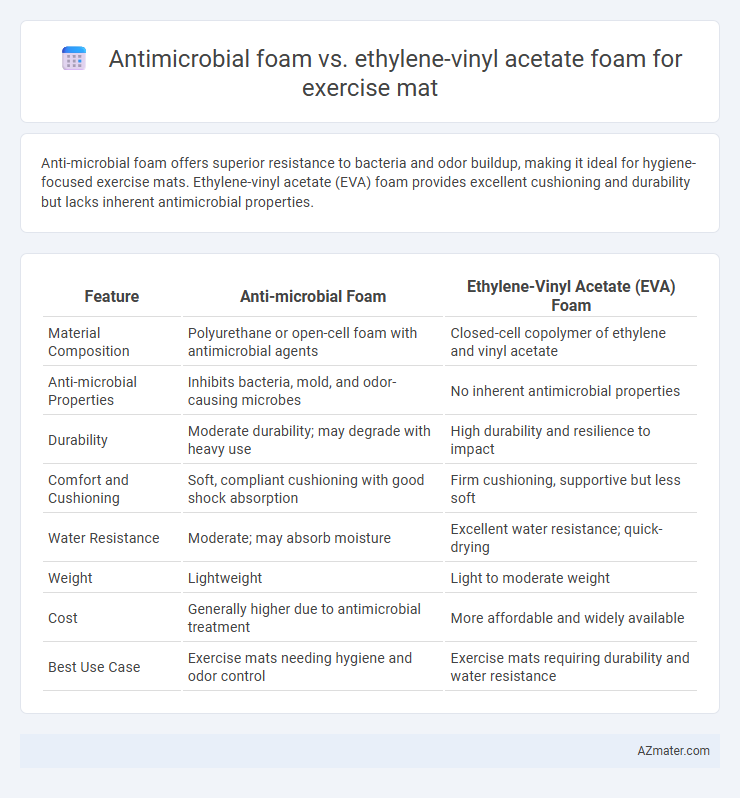Anti-microbial foam offers superior resistance to bacteria and odor buildup, making it ideal for hygiene-focused exercise mats. Ethylene-vinyl acetate (EVA) foam provides excellent cushioning and durability but lacks inherent antimicrobial properties.
Table of Comparison
| Feature | Anti-microbial Foam | Ethylene-Vinyl Acetate (EVA) Foam |
|---|---|---|
| Material Composition | Polyurethane or open-cell foam with antimicrobial agents | Closed-cell copolymer of ethylene and vinyl acetate |
| Anti-microbial Properties | Inhibits bacteria, mold, and odor-causing microbes | No inherent antimicrobial properties |
| Durability | Moderate durability; may degrade with heavy use | High durability and resilience to impact |
| Comfort and Cushioning | Soft, compliant cushioning with good shock absorption | Firm cushioning, supportive but less soft |
| Water Resistance | Moderate; may absorb moisture | Excellent water resistance; quick-drying |
| Weight | Lightweight | Light to moderate weight |
| Cost | Generally higher due to antimicrobial treatment | More affordable and widely available |
| Best Use Case | Exercise mats needing hygiene and odor control | Exercise mats requiring durability and water resistance |
Introduction to Exercise Mat Materials
Exercise mats commonly utilize materials like anti-microbial foam and ethylene-vinyl acetate (EVA) foam, each offering distinct benefits for fitness enthusiasts. Anti-microbial foam is infused with agents that inhibit the growth of bacteria and fungi, enhancing hygiene and reducing odor during sweaty workouts. In contrast, ethylene-vinyl acetate foam provides excellent cushioning, shock absorption, and durability, making it a popular choice for high-impact exercises and prolonged use.
What is Anti-Microbial Foam?
Anti-microbial foam is a specialized material treated with agents that inhibit the growth of bacteria, mold, and mildew, making it ideal for exercise mats by maintaining hygiene and reducing odors. Ethylene-vinyl acetate (EVA) foam, widely used in mats for its durability and cushioning, lacks inherent anti-microbial properties. Choosing anti-microbial foam ensures enhanced cleanliness and longevity in workout environments where sweat and moisture are prevalent.
Overview of Ethylene-Vinyl Acetate (EVA) Foam
Ethylene-vinyl acetate (EVA) foam is a lightweight, flexible, and durable material commonly used in exercise mats due to its excellent shock absorption and cushioning properties. Its closed-cell structure provides resistance to moisture, mold, and microbial growth, promoting hygiene and longevity. EVA foam also offers good insulation and comfort, making it a preferred choice for fitness enthusiasts seeking a balance of support and cleanliness.
Key Features: Anti-Microbial Properties
Anti-microbial foam used in exercise mats incorporates agents like silver ions or copper compounds that inhibit bacterial and fungal growth, enhancing hygiene and reducing odor over prolonged use. Ethylene-vinyl acetate (EVA) foam offers durability and cushioning but generally lacks inherent anti-microbial properties unless treated with additives, which may degrade over time. Choosing anti-microbial foam ensures a cleaner workout surface, particularly beneficial for high-sweat environments and frequent gym use.
Durability and Lifespan Comparison
Anti-microbial foam offers enhanced resistance to microbial growth, extending exercise mat hygiene and reducing material degradation over time, resulting in a longer lifespan compared to standard foams. Ethylene-vinyl acetate (EVA) foam provides excellent durability due to its high resilience and shock absorption, maintaining structural integrity under repeated stress and heavy use. While EVA foam excels in physical durability, anti-microbial foam adds value through prolonged cleanliness and material preservation, making the choice dependent on user priorities between longevity and sanitation.
Comfort and Cushioning Performance
Anti-microbial foam enhances exercise mat hygiene by inhibiting bacterial growth, maintaining a fresh and odor-free surface. Ethylene-vinyl acetate (EVA) foam offers superior cushioning with its lightweight, flexible structure that absorbs impact effectively during workouts. Both materials provide comfort, but EVA foam typically delivers better shock absorption and durability, while anti-microbial foam prioritizes cleanliness and long-term freshness.
Hygiene and Maintenance Needs
Anti-microbial foam used in exercise mats actively inhibits bacterial growth, reducing odors and minimizing the risk of skin infections, which enhances hygiene significantly compared to standard foams. Ethylene-vinyl acetate (EVA) foam offers water resistance and easy wipe-down maintenance but lacks inherent antimicrobial properties, requiring regular cleaning to prevent microbial buildup. Choosing anti-microbial foam lowers long-term maintenance needs by promoting a cleaner surface with less frequent sanitization required.
Safety and Allergen Considerations
Anti-microbial foam used in exercise mats contains biocides that inhibit bacterial and fungal growth, significantly reducing the risk of mold-related allergens and skin irritations during intense workouts. Ethylene-vinyl acetate (EVA) foam is hypoallergenic and free from latex, minimizing allergic reactions, but it lacks inherent anti-microbial properties, potentially allowing microbial buildup over time. Prioritizing safety, anti-microbial foam offers superior protection against pathogens, while EVA foam is preferred for users with chemical sensitivities or latex allergies.
Environmental Impact and Sustainability
Anti-microbial foam used in exercise mats often contains chemical additives that can hinder biodegradability and contribute to environmental pollution, whereas ethylene-vinyl acetate (EVA) foam is recognized for its durability and partial recyclability, offering a more sustainable option. EVA foam production generally involves lower greenhouse gas emissions compared to antimicrobial foams with complex chemical treatments, making it a greener choice for eco-conscious consumers. However, neither material is fully biodegradable, highlighting the importance of recycling programs and alternative eco-friendly materials in reducing overall environmental impact.
Which Exercise Mat is Best for You?
Anti-microbial foam exercise mats offer enhanced hygiene by preventing bacteria and fungi growth, making them ideal for users with allergies or sensitive skin. Ethylene-vinyl acetate (EVA) foam mats provide superior cushioning and durability, supporting joint protection during high-impact workouts. Choosing the best exercise mat depends on your priority for cleanliness versus impact absorption and long-term resilience.

Infographic: Anti-microbial foam vs Ethylene-vinyl acetate foam for Exercise mat
 azmater.com
azmater.com